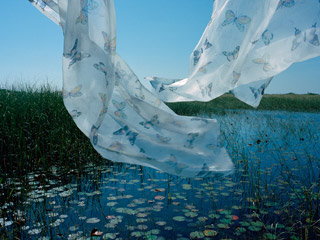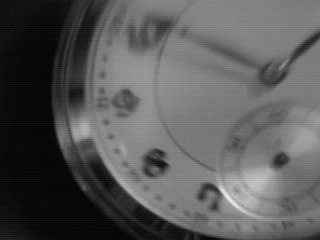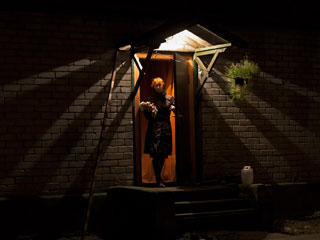Ellie Davies
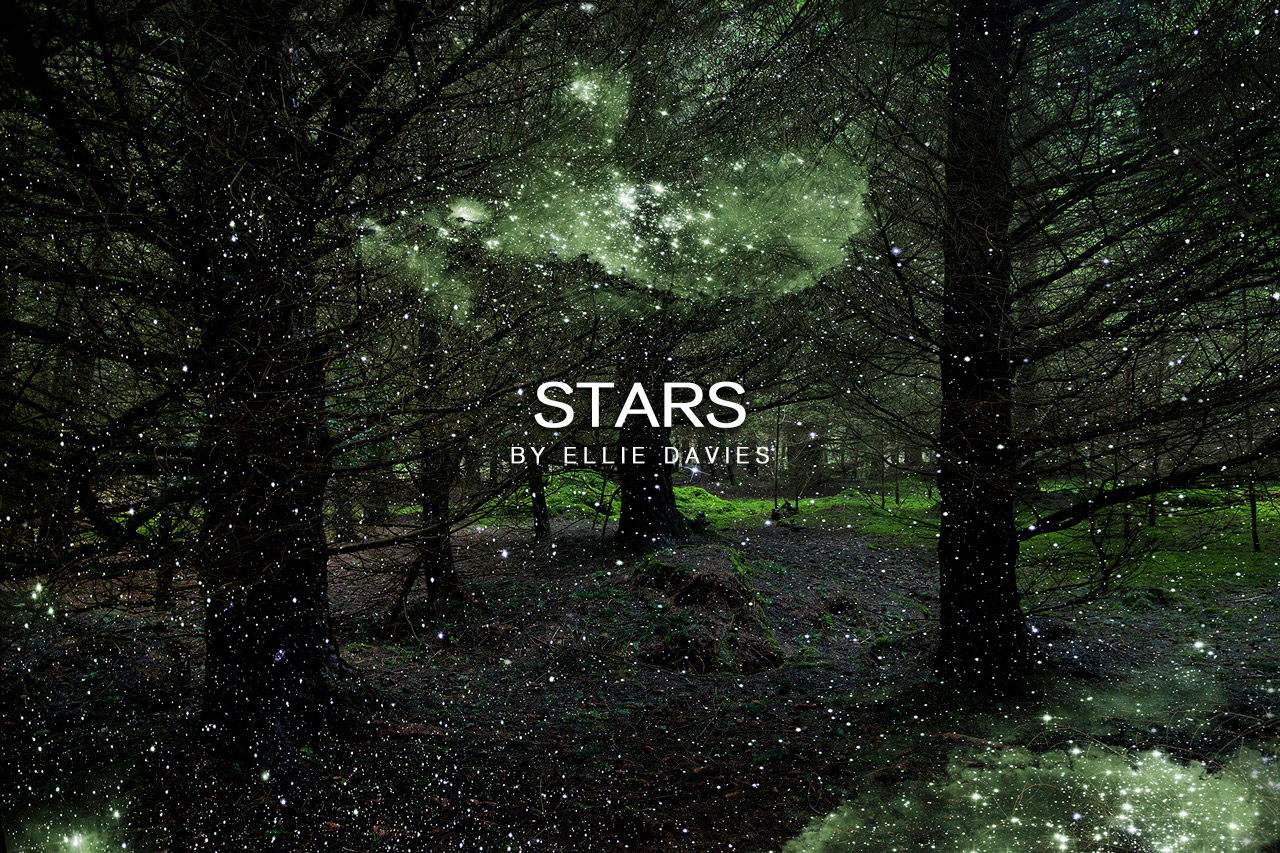
Stars, 2014 explores my desire to find some balance between a relationship with the wild places of my youth, and a pervasive sense of disconnectedness with the natural world.
The Western landscape tradition embodies a pairing that James Elkins calls ‘the subject-object relationship’. Typified by the ‘scenic viewpoint’ or tourist panoramic overlook, we gaze, often through binoculars or telescopes, at wide vistas and dramatic seascapes, awed and overwhelmed. But this landscape experience often alienates the viewer from the scene and, just as the landscape itself becomes an object, a separation arises between them.
Today the majority of people live in urban or semi-urban environments, experiencing the landscape from a distanced position mediated through various media and technology. From this viewpoint the notion of the landscape in all its sensuous materiality, our being within it rather than outside it, seems beyond reach.
Stars, 2014 addresses this distancing by drawing the viewer right into the heart of a forest which still holds mystery, and offers the potential for discovery and exploration. The series considers the fragility of our relationship with the natural world, and the temporal and finite nature of landscape as a human construct.
Mature and ancient forest landscapes are interposed with images of the Milky Way, Omega Centauri, the Norma Galaxy and Embryonic stars in the Nebula NGC 346 captured by the Hubble Telescope. Each image links forest landscapes with the intangible and unknown universe creating a juxtaposition that reflects my personal experiences of the forest; its physicality and tactility set against a profound and fundamental otherness, an alienation that separates us from a truly immersive relationship with the natural world.
(Source Material Credit: STScI/Hubble & NASA)















 Ellie Davies (England, 1976). Lives in London and works in the woods and forests of Southern England. She gained her MA in Photography from London College of Communication in 2008. She has recently been selected Landscape Winner in PDN’s The Curator Awards 2016. The six winning artists were exhibited at Foley Gallery in New York from 14 - 24 July 2016. Her Stars series was selected for the Aesthetica Art Prize 2016 and received The People Choice Award and has also been selected for exhibition at the Singapore International Photo Festival in October 2016. The Roe Valley Arts and Cultural Centre in Northern Ireland will host a solo exhibition of her images in April 2017.
Ellie Davies (England, 1976). Lives in London and works in the woods and forests of Southern England. She gained her MA in Photography from London College of Communication in 2008. She has recently been selected Landscape Winner in PDN’s The Curator Awards 2016. The six winning artists were exhibited at Foley Gallery in New York from 14 - 24 July 2016. Her Stars series was selected for the Aesthetica Art Prize 2016 and received The People Choice Award and has also been selected for exhibition at the Singapore International Photo Festival in October 2016. The Roe Valley Arts and Cultural Centre in Northern Ireland will host a solo exhibition of her images in April 2017.
Stars, 2014 explores my desire to find some balance between a relationship with the wild places of my youth, and a pervasive sense of disconnectedness with the natural world.
The Western landscape tradition embodies a pairing that James Elkins calls ‘the subject-object relationship’. Typified by the ‘scenic viewpoint’ or tourist panoramic overlook, we gaze, often through binoculars or telescopes, at wide vistas and dramatic seascapes, awed and overwhelmed. But this landscape experience often alienates the viewer from the scene and, just as the landscape itself becomes an object, a separation arises between them.
Today the majority of people live in urban or semi-urban environments, experiencing the landscape from a distanced position mediated through various media and technology. From this viewpoint the notion of the landscape in all its sensuous materiality, our being within it rather than outside it, seems beyond reach.
Stars, 2014 addresses this distancing by drawing the viewer right into the heart of a forest which still holds mystery, and offers the potential for discovery and exploration. The series considers the fragility of our relationship with the natural world, and the temporal and finite nature of landscape as a human construct.
Mature and ancient forest landscapes are interposed with images of the Milky Way, Omega Centauri, the Norma Galaxy and Embryonic stars in the Nebula NGC 346 captured by the Hubble Telescope. Each image links forest landscapes with the intangible and unknown universe creating a juxtaposition that reflects my personal experiences of the forest; its physicality and tactility set against a profound and fundamental otherness, an alienation that separates us from a truly immersive relationship with the natural world.
(Source Material Credit: STScI/Hubble & NASA)















 Ellie Davies (England, 1976). Lives in London and works in the woods and forests of Southern England. She gained her MA in Photography from London College of Communication in 2008. She has recently been selected Landscape Winner in PDN’s The Curator Awards 2016. The six winning artists were exhibited at Foley Gallery in New York from 14 - 24 July 2016. Her Stars series was selected for the Aesthetica Art Prize 2016 and received The People Choice Award and has also been selected for exhibition at the Singapore International Photo Festival in October 2016. The Roe Valley Arts and Cultural Centre in Northern Ireland will host a solo exhibition of her images in April 2017.
Ellie Davies (England, 1976). Lives in London and works in the woods and forests of Southern England. She gained her MA in Photography from London College of Communication in 2008. She has recently been selected Landscape Winner in PDN’s The Curator Awards 2016. The six winning artists were exhibited at Foley Gallery in New York from 14 - 24 July 2016. Her Stars series was selected for the Aesthetica Art Prize 2016 and received The People Choice Award and has also been selected for exhibition at the Singapore International Photo Festival in October 2016. The Roe Valley Arts and Cultural Centre in Northern Ireland will host a solo exhibition of her images in April 2017.Rebecca Reeve

The miracle of light pours over the green and brown expanse of saw grass and of water, shining and slowly moving, the grass and the water that is the meaning and the central fact of the Everglades. It is a river of grass. —Marjory Stoneman Douglas
I began this series during my AIRIE residency in the Everglades in December 2012. It draws inspiration from a ritual described in The Rings of Saturn by W.G. Sebald. In Holland in the 1600s, during the wake of the deceased, it was customary to cover all mirrors, landscape paintings and portraits in the home with cloths. It was believed this would make it easier for the soul to leave the body and subdue any temptations for it to stay in this world.
The ritual seemed, by extension, to be a confirmation of the deeply moving experience that one often feels in the natural environment, and thus provided both a literal and contextual frame within which to shoot the landscape, a portal from the domestic into the wilderness. The curtains, all purchased from Goodwill and Salvation Army stores in south Florida and Utah, represent a ‘social fabric’ with a history already attached to them. In our increasingly urban existence that ever distances us from the wilderness experience, the drapes serve as visual connectors to the familiar.
Images from the Marjory's World series will be on show in the exhibition 'Mise en Scene' opening March 16th at Hazan Projects in New York City.





















 Rebecca Reeve (England) She received her Bachelor of Fine Arts degree at Bath Spa University and a Masters of Visual Arts at the University of South Wales, Australia. Her photographs have been exhibited nationally and internationally including La Biennale de Montreal, (Canada), Freies Museum, Berlin, (Germany), Museum of Latin American Art, (Buenos Aires), EFA Project Space, (NYC) and the Masur Museum of Art, (Louisiana). In 2013 she was Artist in Residence at AIRIE and the recipient of the Artist in Exploration grant underwritten by Rolex. In 2016 she will be Artist in Residence at Joshua Tree National Park. She lives and works in New York City.
Rebecca Reeve (England) She received her Bachelor of Fine Arts degree at Bath Spa University and a Masters of Visual Arts at the University of South Wales, Australia. Her photographs have been exhibited nationally and internationally including La Biennale de Montreal, (Canada), Freies Museum, Berlin, (Germany), Museum of Latin American Art, (Buenos Aires), EFA Project Space, (NYC) and the Masur Museum of Art, (Louisiana). In 2013 she was Artist in Residence at AIRIE and the recipient of the Artist in Exploration grant underwritten by Rolex. In 2016 she will be Artist in Residence at Joshua Tree National Park. She lives and works in New York City.
The miracle of light pours over the green and brown expanse of saw grass and of water, shining and slowly moving, the grass and the water that is the meaning and the central fact of the Everglades. It is a river of grass. —Marjory Stoneman Douglas
I began this series during my AIRIE residency in the Everglades in December 2012. It draws inspiration from a ritual described in The Rings of Saturn by W.G. Sebald. In Holland in the 1600s, during the wake of the deceased, it was customary to cover all mirrors, landscape paintings and portraits in the home with cloths. It was believed this would make it easier for the soul to leave the body and subdue any temptations for it to stay in this world.
The ritual seemed, by extension, to be a confirmation of the deeply moving experience that one often feels in the natural environment, and thus provided both a literal and contextual frame within which to shoot the landscape, a portal from the domestic into the wilderness. The curtains, all purchased from Goodwill and Salvation Army stores in south Florida and Utah, represent a ‘social fabric’ with a history already attached to them. In our increasingly urban existence that ever distances us from the wilderness experience, the drapes serve as visual connectors to the familiar.
Images from the Marjory's World series will be on show in the exhibition 'Mise en Scene' opening March 16th at Hazan Projects in New York City.





















 Rebecca Reeve (England) She received her Bachelor of Fine Arts degree at Bath Spa University and a Masters of Visual Arts at the University of South Wales, Australia. Her photographs have been exhibited nationally and internationally including La Biennale de Montreal, (Canada), Freies Museum, Berlin, (Germany), Museum of Latin American Art, (Buenos Aires), EFA Project Space, (NYC) and the Masur Museum of Art, (Louisiana). In 2013 she was Artist in Residence at AIRIE and the recipient of the Artist in Exploration grant underwritten by Rolex. In 2016 she will be Artist in Residence at Joshua Tree National Park. She lives and works in New York City.
Rebecca Reeve (England) She received her Bachelor of Fine Arts degree at Bath Spa University and a Masters of Visual Arts at the University of South Wales, Australia. Her photographs have been exhibited nationally and internationally including La Biennale de Montreal, (Canada), Freies Museum, Berlin, (Germany), Museum of Latin American Art, (Buenos Aires), EFA Project Space, (NYC) and the Masur Museum of Art, (Louisiana). In 2013 she was Artist in Residence at AIRIE and the recipient of the Artist in Exploration grant underwritten by Rolex. In 2016 she will be Artist in Residence at Joshua Tree National Park. She lives and works in New York City.Zone Zero
Andy Joule uses a combination of traditional and digital techniques, such as stop-motion, multi-layered image sequences and time-lapse. His time-lapses are more than just a technical sensation, closer to the fields of experimental video or fictional documentary. Time becomes the protagonist. Objects that seem to be inert at first, begin to change; a process that only becomes visible by the layer of time that is put over the presented sequences. In this way, the work of Joule brings about the manipulation, deconstruction and reinterpretation of time and space, proposing unconventional narratives and new ways of understanding time in short audiovisual formats.
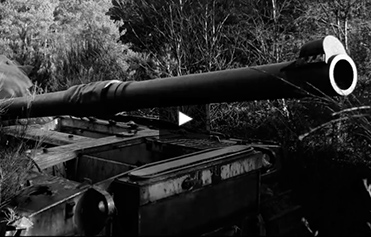 SALVAGE
SALVAGEInspired by a quote from the naturalist Jacques Yves Cousteau, this film explores the way in which nature clings to life, finds a foothold, and ultimately reclaims what is hers. The solidity of these metal beasts is questioned as the rust and flake slowly leak into the ground.
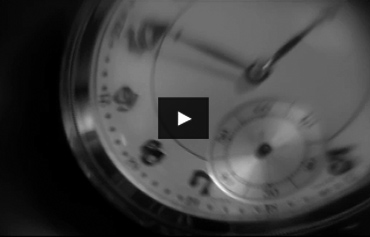 ELIPSIS
ELIPSIS Andy Joule is a film-maker and animator. He studied animation at West Surrey College of Art & Design. After graduating he worked in London, Manchester, Bristol, the Netherlands and in the US. His films have been screened in festivals and competitions around the world. He has lectured at Volda University College, Norway and is a Senior Lecturer in Animation at the University for the Creative Arts. He is also a BAFTA juror and a Fellow of the Royal Society of Arts.
Andy Joule is a film-maker and animator. He studied animation at West Surrey College of Art & Design. After graduating he worked in London, Manchester, Bristol, the Netherlands and in the US. His films have been screened in festivals and competitions around the world. He has lectured at Volda University College, Norway and is a Senior Lecturer in Animation at the University for the Creative Arts. He is also a BAFTA juror and a Fellow of the Royal Society of Arts.Andy Joule uses a combination of traditional and digital techniques, such as stop-motion, multi-layered image sequences and time-lapse. His time-lapses are more than just a technical sensation, closer to the fields of experimental video or fictional documentary. Time becomes the protagonist. Objects that seem to be inert at first, begin to change; a process that only becomes visible by the layer of time that is put over the presented sequences. In this way, the work of Joule brings about the manipulation, deconstruction and reinterpretation of time and space, proposing unconventional narratives and new ways of understanding time in short audiovisual formats.
 SALVAGE
SALVAGEInspired by a quote from the naturalist Jacques Yves Cousteau, this film explores the way in which nature clings to life, finds a foothold, and ultimately reclaims what is hers. The solidity of these metal beasts is questioned as the rust and flake slowly leak into the ground.
 ELIPSIS
ELIPSIS Andy Joule is a film-maker and animator. He studied animation at West Surrey College of Art & Design. After graduating he worked in London, Manchester, Bristol, the Netherlands and in the US. His films have been screened in festivals and competitions around the world. He has lectured at Volda University College, Norway and is a Senior Lecturer in Animation at the University for the Creative Arts. He is also a BAFTA juror and a Fellow of the Royal Society of Arts.
Andy Joule is a film-maker and animator. He studied animation at West Surrey College of Art & Design. After graduating he worked in London, Manchester, Bristol, the Netherlands and in the US. His films have been screened in festivals and competitions around the world. He has lectured at Volda University College, Norway and is a Senior Lecturer in Animation at the University for the Creative Arts. He is also a BAFTA juror and a Fellow of the Royal Society of Arts.Bahbak Hashemi-Nezhad
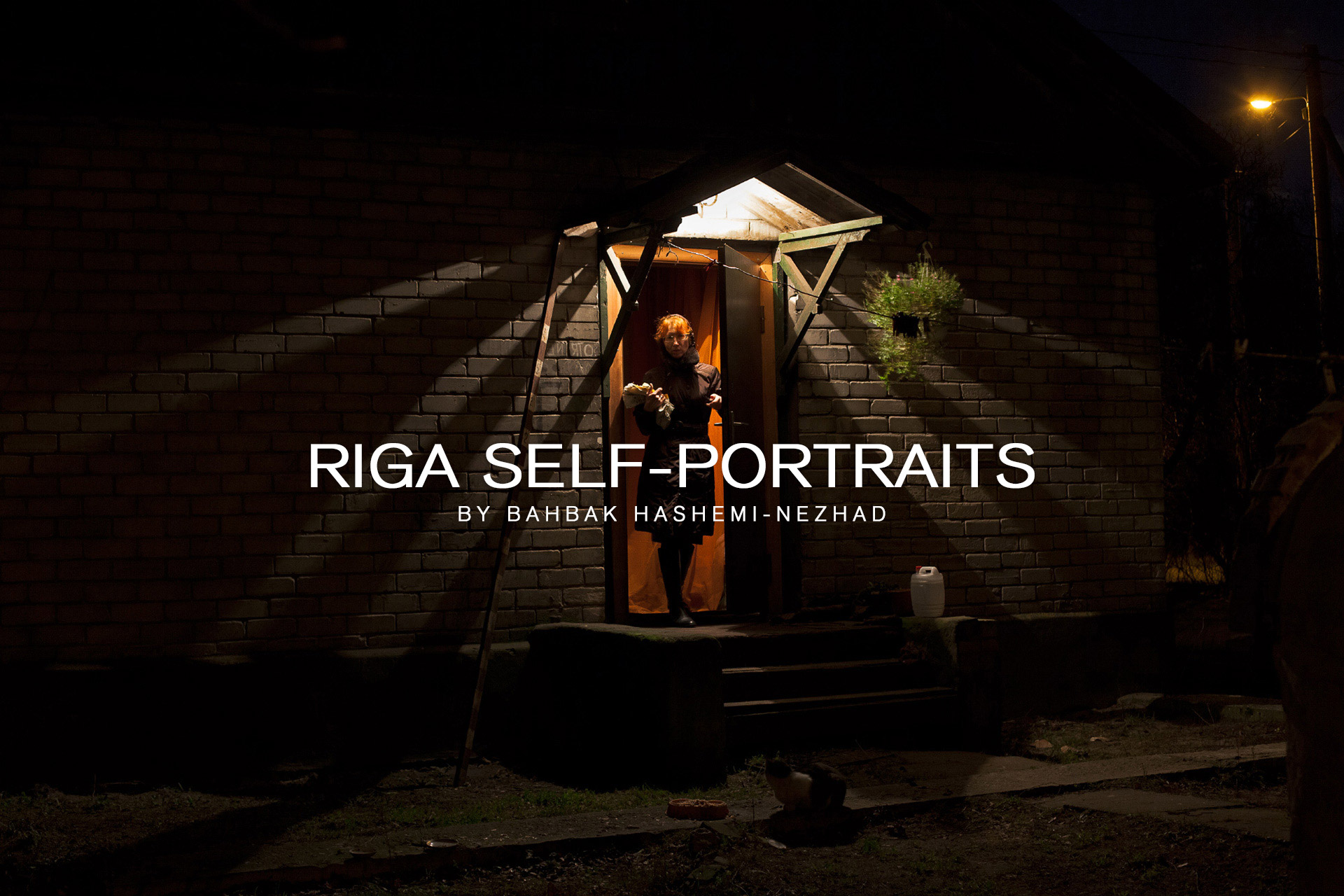
These images are the results of chance public encounters during a series of walks in Bolderaja, a largely Russian-speaking area of Riga which was industrialised and militarised during the soviet occupation.
Over three days in late November 2013, members of the public were requested to remotely photograph themselves and momentarily act out their everyday realities whilst continuing the situations in which they were encountered.
Set against new and yet to be completed housing developments, industrial estates, local businesses and suburban landscapes, these self-portraits act as vignettes, highlighting the roles the individuals play and the pleasures they experience in the public realm.


















The Riga Self-portraits were made in the context of the international community art project 'Contemporary Self-Portraits'. During this two-year project (September 2012–August 2014), self-portrait workshops were held in various European regions: Finland (Turku), Estonia (Tallinn), Ireland (Dublin), Latvia (Riga) and Sweden (Umeå).
The aim was to give local inhabitants a voice in expressing their personal and collective identity, as well as to encourage the development and sharing of communal art methodology and community development through arts.
The results were presented at exhibitions in each partner country and at a Final Symposium in Umea in 2014.
 Bahbak Hashemi-Nezhad (England, 1979). He graduated from the Royal College of Art in 2008 and founded a cross-disciplinary practice that has produced work ranging from product design, domestic and public spaces, photography, to food, games and public interventions. His practice is concerned with exploring the role of photography within design research, and with developing new design methodologies that actively engage individual users. bh-n.com
Bahbak Hashemi-Nezhad (England, 1979). He graduated from the Royal College of Art in 2008 and founded a cross-disciplinary practice that has produced work ranging from product design, domestic and public spaces, photography, to food, games and public interventions. His practice is concerned with exploring the role of photography within design research, and with developing new design methodologies that actively engage individual users. bh-n.com
These images are the results of chance public encounters during a series of walks in Bolderaja, a largely Russian-speaking area of Riga which was industrialised and militarised during the soviet occupation.
Over three days in late November 2013, members of the public were requested to remotely photograph themselves and momentarily act out their everyday realities whilst continuing the situations in which they were encountered.
Set against new and yet to be completed housing developments, industrial estates, local businesses and suburban landscapes, these self-portraits act as vignettes, highlighting the roles the individuals play and the pleasures they experience in the public realm.


















The Riga Self-portraits were made in the context of the international community art project 'Contemporary Self-Portraits'. During this two-year project (September 2012–August 2014), self-portrait workshops were held in various European regions: Finland (Turku), Estonia (Tallinn), Ireland (Dublin), Latvia (Riga) and Sweden (Umeå).
The aim was to give local inhabitants a voice in expressing their personal and collective identity, as well as to encourage the development and sharing of communal art methodology and community development through arts.
The results were presented at exhibitions in each partner country and at a Final Symposium in Umea in 2014.
 Bahbak Hashemi-Nezhad (England, 1979). He graduated from the Royal College of Art in 2008 and founded a cross-disciplinary practice that has produced work ranging from product design, domestic and public spaces, photography, to food, games and public interventions. His practice is concerned with exploring the role of photography within design research, and with developing new design methodologies that actively engage individual users. bh-n.com
Bahbak Hashemi-Nezhad (England, 1979). He graduated from the Royal College of Art in 2008 and founded a cross-disciplinary practice that has produced work ranging from product design, domestic and public spaces, photography, to food, games and public interventions. His practice is concerned with exploring the role of photography within design research, and with developing new design methodologies that actively engage individual users. bh-n.com


